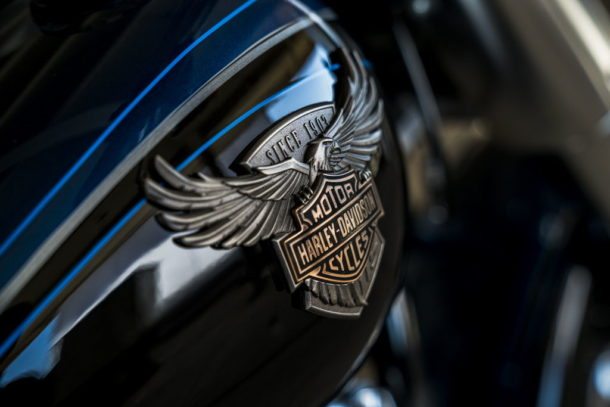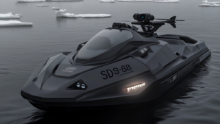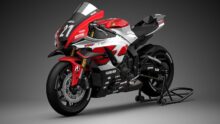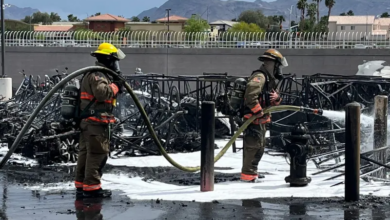MOTORCYCLE – JD Power #2: How New Bike Buyers Choose Their Dealers
As mentioned in Part I, the methodology of the J.D. Power and Associates (JDPA) 2004 Motorcycle Competitive Information Study (MCIS) was to mail a survey to 45,062 people who had purchased a new street or dual-sport motorcycle between September of 2003 and May of 2004. Names were selected at random by JDPA from lists furnished by the manufacturers. Each questionnaire included a $1 bill as an incentive, and reminder postcards were mailed a few days after the survey arrived. J.D. Power and Associates received more than 10,000 usable responses. Included were 49 often multi-part questions about the newly purchased motorcycles, 10 questions about helmets and 12 demographic questions.
INFORMATION SOURCES
Asked what information sources were used while shopping for a new motorcycle, the top five responses checked were “Display at showroom” (45.9%), “Internet” (34.9%), “Friends/Relatives” (34.7%), “Dealer personnel” (32.5%), and “Magazine article/guide” (31.9%). Other double-digit responses included “Past experience” (29.3%), “Product brochure” (27.1%), “Other riders” (26.9%), “Display at show/rally” (12.6%) and “Test ride” (11.9%). Only 8.4% said they were persuaded by an advertisement, and 5.8% checked “Other.”
INTERNET
Asked what, if any, information consumer received from the Internet, the top five reasons checked were that they used the Web to obtain “Manufacturer’s product features and specs,” (71.7%), “Aftermarket accessories/parts” (50.5%), “Dealer locations/promotions” (36.1%), “Pricing/financing” (34.9%) and “Independent product reviews and ratings” (31.7%).
PRICE PAID
The mean/weighted average price they reported paying per bike was $12,665, which means that roughly half paid more and half paid less. As for price groupings, the MCIS showed that 25.5% paid $8,000 or less, and 29.4% paid from $8,001 to $12,000. Curiously, there’s a barren land ranging from $12,001 to $15,000, as only 7.5% reported paying a price in this range. Finally, 37.7% paid more than $15,000, including the 8.7% who reported paying more than $20,000 for their new bikes!
PG&A
Asked what they bought with their new motorcycle, and what they spent on the PG&A, 55.3% of new bike buyers reported buying accessories, and the mean/weighted average spent on them was $1,162. Another 30.1% bought riding gear, spending an average of $425, and 24.9% purchased an Extended Service Contract for an average of $824. Only 27.9% reported making no additional purchase, and those cheapskates spent zip!
PLACE OF PURCHASE
Consumer were asked the main reasons for buying their new motorcycle at a particular dealership.
In order, those responses listed in double figures included “Dealer had the motorcycle (color option, etc.) I wanted” (58.3%), “Conveniently located” (47.0%), “Best deal/lowest price (39.3%), “Hassle-free negotiations/made me feel comfortable” (39.2%), “Dealer reputation” (25.8%) and “Past experience with dealer” (23.9%). Responses of lesser frequency included “Dealer was able to get me financed” (9.5%), and “Dealer convinced me of the benefits of buying” (2.3%). An indecisive 5.6% reported “No particular reason.”
INFLUENCE
Consumer were then asked what what, from the reasons supplied above, most influenced their dealership choice.
When it came down to one single reason consumers chose a dealer, they checked “Dealer had the motorcycle I wanted” 26.1% of the time. “Best deal/lowest price” was listed by 21.6%, and 15.4% checked “Conveniently located.” The only other factors with responses in double figures were “Past experience with dealer” (13.4%) and “Hassle-free negotiations” (11.9%).
The MCIS survey has changed format over the years, and the specific wording of some questions has shifted. Still, the 1998 MCIS listed a similar question. Rider responses ran the gamut from simply “Had the model I wanted” (25.1%), to “Prior experience with the dealer” (21.1%), “Price” (18.6%), “Dealer location” (14.7%) and “Attitude of dealer personnel” (10.4%). Factors that ranked in single digits included, “Low pressure selling environment” (4.5%) and “Favorable finance terms (2.1%).”
BUYING EXPERIENCE
Were bike buyers happy with their buying experience?
Using a 1-10 Scale, where 1 is Unacceptable, 10 is Outstanding and 5 is Average:”
Here are their responses to a number of areas covered by the above question:
Overall rating of dealer product offering: 39.2%, 10-9; 5.7%, 8-7; 25.1%, 6 or beow
Overall rating of sales personnel: 57.7%, 10-9; 24.8%, 8-7; 17.6%, 6 or below
Overall rating of dealer sales process: 54.1%, 10-9; 26.4%, 8-7; 19.6%, 6 or below
Overall rating of dealer delivery: 60.0%, 10-9; 22.9%, 8-7; 17.1%, 6 or below
OVERALL DEALERSHIP EXPERIENCE
Nearly 75% of respondents rate their overall experience at the dealership an “8” or better (based on the JDPA 10-point scale).
Let’s get a little more precise with overall dealer satisfaction. For this most important factor, 35.6% rated their dealer a perfect “10,” or “Outstanding.” Another 22.7% gave them a “9,” which means that a total of 58.3% were pretty darn happy with the experience. Another 25.0% gave their dealer a “7” or “8,” and 10.9% gave their dealer a rating of “5” or “6.”
EXPECTATIONS
Queried how the buyers overall experience compared with their expectations, most respondents (54.7%) said their dealer “Met expectations,” while another 36.4% said they were “Above expectations.” That latter could well mean that consumers had a very low expectation of motorcycle dealers, but were pleasantly surprised. Combine this with the above question, and it means that most consumers went into a motorcycle shop expecting a good or better experience–and got it. Some 9.0% reported that the experience was “Below expectations.”
TEST RIDES
We understand the potential legal problems with providing test rides to prospective buyers. However, buyers who get test rides consider them very influential. Only 31.5% of buyers reported that they were given the opportunity to take a test ride. Strangely, of those so offered, only 42.1% actually accepted the offer.
When asked “Please indicate the degree to which the test ride influenced your decision to purchase this specific model,” 61.1% said it was a “Strong influence,” and 29.2% said it was a “Moderate influence.” Though only 31.5% of respondents were given the opportunity to take a test ride, they all bought a new bike. psb
Next Issue – In our third installment, we’ll reveal how new-bike buyers rated their motorcycles, the service department, and what accessories they purchased. Our fourth and final installment will reveal which brands of helmets were rated above average by buyers.
About J.D. Power and Associates
Headquartered in Westlake Village, California, J.D. Power and Associates is an ISO 9001-registered global marketing information services firm operating in key business sectors including market research, forecasting, consulting, training and customer satisfaction. The firm’s quality and satisfaction measurements are based on responses from millions of consumers annually. J.D. Power and Associates is a business unit of The McGraw-Hill Companies.
– Bill Stermer





